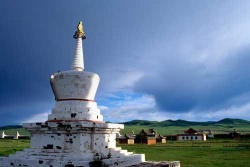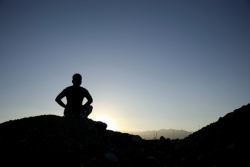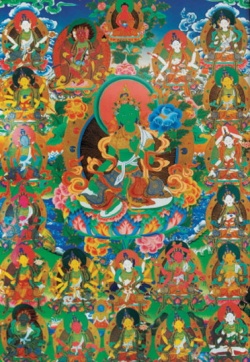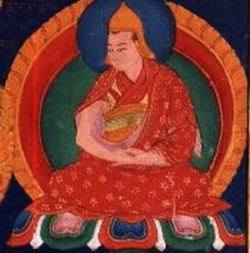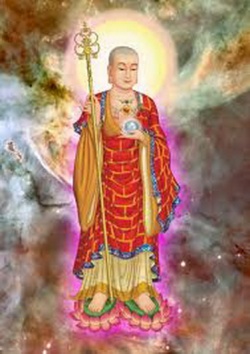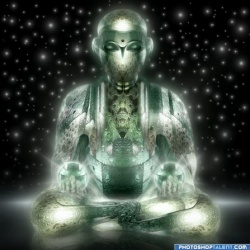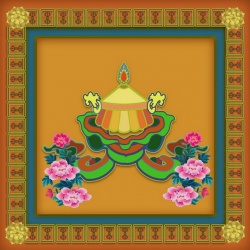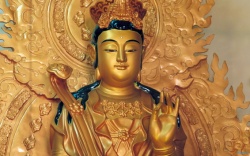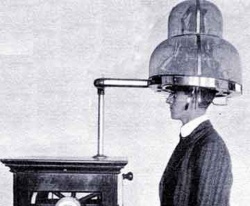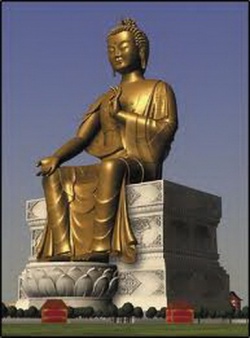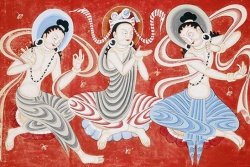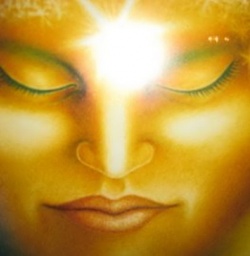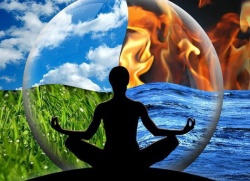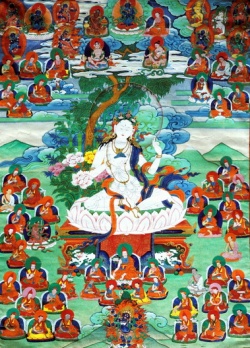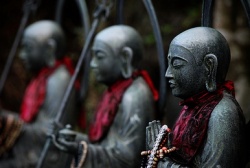The Secret Book of Dzyan
In numerous articles here on this site I have stated that the truth, validity, and legitimacy of Madame Blavatsky’s statements, claims, and teachings is being increasingly confirmed and that now, finally, over a century since her passing, she has been – and continues to be – exonerated and validated at every turn.
I’ve also mentioned that the actual existence of her “Stanzas from the Secret Book of Dzyan” has finally been confirmed by researchers who have found that they are connected with the innermost teachings of the Kalachakra, the latter having become publicly known in recent years due to the Dalai Lama’s teaching. The Dalai Lama himself endorses Blavatsky’s work, as will be shown later in the present article. Other widely respected luminaries, including Mahatma Gandhi and Albert Einstein, also had much praise for her and held her in high regard. In fact,
her work, writings, and legacy are now beginning to be treated with such respect and seriousness (perhaps partly due to the fact that the old accusations of forgery and plagiarism have been proven completely baseless and deceitful, as perfectly shown and documented in “HPB: The Extraordinary Life and Influence of Helena Blavatsky” by Sylvia Cranston) that a leading English university has recently begun to offer a degree course in Theosophical studies.
Unfortunately many people remain unaware of such facts as stated in the above and thus they continue to either be unable to adequately defend Blavatsky and their own beliefs (if they are a Theosophist) or they continue to ignorantly dismiss her as a fraud and charlatan, repeating the same old and fallacious assertions ad infinitum, never even bothering to do any unprejudiced research of their own into the matter, nor conceding that anything other than their ill-informed opinions could ever be the case.
As many know, HPB’s great work “The Secret Doctrine” is based on a series of stanzas from what she calls the Secret Book of Dzyan. “Dzyan” is derived from the Sanskrit word “Dhyana”, meaning mystic meditation. In describing what the Book of Dzyan is, she makes reference to the books of Kiu-Te and says that there are 35 exoteric volumes of Kiu-Te (which “may be found in the possession of the Tibetan Gelugpa
Lamas, in the library of any monastery”), about which there are 14 volumes of commentaries, and also 7 secret or esoteric volumes of Kiu-Te. The first volume of the commentaries on these esoteric works is the Book of Dzyan. The Book of Dzyan, she explains, is a Book of Commentaries on the secret, esoteric Kiu-Te volumes and also a Glossary of the public, exoteric Kiu-Te volumes. The seven esoteric volumes “are kept secret and apart, in the charge of” the Panchen Lama of Shigatse.
However, since there is now no longer a Panchen Lama of, or at, Shigatse (see the article The Great Tsong Kha-pa for further explanation) this last sentence is doubtless no longer quite accurate.
The seven stanzas quoted from in the first volume of “The Secret Doctrine” ( that first volume being titled “Cosmogenesis”) “refer to, and describe the seven great stages of the evolutionary process, which are spoken of in the Puranas as the ‘Seven Creations,’ and in the Bible as the ‘Days’ of
Creation.” Who, having read them, can forget the tremendous and inspirational beauty of the first stanza, given the title of “The Night of the Universe,” which symbolically describes “the state of the ONE ALL during Pralaya [the cyclic period of total inactivity and non-existence following the dissolution of the previous “incarnation” of the universe), before the first flutter of re-awakening manifestation”? –
STANZA I.
1. The eternal parent wrapped in her ever invisible robes had slumbered once again for seven eternities.
2. Time was not, for it lay asleep in the infinite bosom of duration.
3. Universal Mind was not, for there were no Ah-hi to contain it.
4. The seven ways to bliss were not. The great causes of misery were not, for there was no one to produce and get ensnared by them.
5. Darkness alone filled the boundless All, for father, mother and son were once more one, and the son had not awakened yet for the new wheel, and his pilgrimage thereon.
6. The seven sublime Lords and the seven truths had ceased to be, and the Universe, the son of Necessity, was immersed in Paranishpanna, to be outbreathed by that which is and yet is not. Naught was.
7. The causes of existence had been done away with; the visible that was, and the invisible that is, rested in eternal non-being – the One Being.
8. Alone the one form of existence stretched boundless, infinite, causeless, in dreamless sleep; and life pulsated unconscious in universal space, throughout that All-Presence which is sensed by the opened eye of the Dangma.
9. But where was the Dangma when the Alaya of the universe was in Paramartha and the great wheel was Anupadaka?
As this article is of necessity relatively short, there is a lot of information that I can’t give here. Any reader who is especially interested by the things mentioned here is strongly encouraged to get a copy of David Reigle’s excellent book “Blavatsky’s Secret Books” which goes into far more depth and detail than I ever can. It is Reigle, after all, who has spent decades researching relentlessly into both the works of Madame Blavatsky and the archives and scriptures of Tibetan Buddhism and who has made the majority of the discoveries summarised in this present article.
The books of Kiu-Te, referred to by HPB, have in fact been found and positively identified as simply being none other than the Tibetan Buddhist Tantras. Although pronounced “Kiu-Te” the spelling frequently used by academics is “rGyud-sde”. Reigle writes, “The problem of the identification of the books of Kiu-te was largely due to the phonetic transcription of the name, ‘Kiu-te,’ which when rendered in its
unphonetic transliteration would be ‘rGyud-sde.’ It is a Tibetan word, and like most Tibetan words, is not spelled like it sounds. Since there was no standard transliteration system for Tibetan in use during H.P. Blavatsky’s time, she had little choice but to adopt the phonetic spellings.”
I should briefly mention the issue of Tantra because it’s important to understand that the Buddhist Tantra is a very different thing from the Hindu Tantra. The Hindu Tantras basically deal with how to acquire and use spiritual powers in order to achieve material and selfish aims. A portion – and only a portion – of this involves the use of sexual magic, which is no doubt why the sex-crazed West has misrepresented the word Tantra as being synonymous with sexual practices. Blavatsky, although strongly in favor and support of Hinduism in general, viewed the Hindu tantras as black magic. They are similarly viewed with distaste and even disgust by the vast majority of Hindus and are not in any way representative of the noble religion of Hinduism.
As for the Buddhist Tantras, David Reigle explains, “The clearly stated and daily reiterated purpose in the Tibetan tradition for undertaking Buddhist tantric practice is to free living beings from suffering. These practices are done to produce in oneself the capabilities of a Buddha for use in benefiting the world. This is called the Bodhisattva ideal, by which one sacrifices one’s own earned
liberation to stay behind and help other struggling beings. In the Hindu tantras there is no concern with benefiting anyone but the practitioner. This point cannot be emphasized too strongly: Buddhist tantra is entirely based on the Bodhisattva ideal.”
As can be seen, the same word can have two entirely different – and even opposite – meanings in Buddhism and Hinduism.
Blavatsky said that the exoteric or public volumes of Kiu-Te “may be found in the possession of the Tibetan Gelugpa Lamas, in the library of any monastery.” This has been found to be indeed true but even these exoteric volumes are regarded in the Tibetan tradition as containing the Buddha’s secret teachings and so they continue to have restricted access to outsiders. “Even now only a tiny fraction of them has been translated into English.”
And now to reveal the truth about a book whose very existence has long been questioned and doubted. Did it never occur to the scoffers and sceptics that the title “Book of Dzyan” – which after all means nothing more than “Book of Mystic Meditation” or “Book of Wisdom attained by Meditation” – might simply be a code name or reference name used by Blavatsky both for sake of convenience and also in order to avoid revealing too
much of the secret esoteric teaching of her Masters in Tibet? She said as much herself, writing in “The Secret Doctrine” that “the Book of Dzyan (or ‘Dzan’) is utterly unknown to our philologists, or at any rate was never heard of by them under its PRESENT name.”
THE SECRET BOOK OF DZYAN IS THE MULA KALACHAKRA TANTRA.
The word “mula” means “root” in Sanskrit and the Mula Kalachakra Tantra – also referred to as the Kalachakra Mulatantra – is the hidden esoteric root and source of the more exoteric Kalachakra Tantra, the latter of which has become so widely heard of today due to the Dalai Lama. The Kalachakra Tantra, like virtually all of the major Buddhist tantras known of and available today, is an abridgement of its original namesake counterpart. The lost (lost from the eyes of the profane but forever known to the high initiates and Masters) Mula Kalachakra Tantra
is said by Buddhist experts and historians to contain 12,000 verses and “also stands out among the other tantras because of its connection with the sacred land of Shamballa. Tradition states that the king of Shamballa requested the Kalachakra teachings from Gautama Buddha, and then returned with them to Shamballa, where they became the state religion. It is from Shamballa that the abridged Kalachakra Tantra came to India and Tibet.”
Again, anyone who is interested to know more details about this and who wishes to see the definitive proof that the Book of Dzyan is the Mula Kalachakra Tantra, is referred to “Blavatsky’s Secret Books” by David and Nancy Reigle.
- [Note 15/12/12 - HPB even hinted at the fact of the matter herself when she wrote, in a footnote to her article "The Mystery of Buddha," that "What is given here is taken from the secret portions of Dus Kyi Khorlo (Kala Chakra, in Sanskrit, or the 'Wheel of Time,' or duration)." And in her work "The Voice of The Silence" there is a verse which reads, "Wouldst thou become a Yogi of 'Time's Circle'?" Time's Circle or the Circle/Wheel of Time is of course Kala Chakra in Sanskrit.]
The respected Buddhism expert Richard Taylor has also pointed out something significant in this regard in his series of articles titled “Blavatsky and Buddhism.” By means of comparison he settles the matter once and for all by showing that:
1. In the 1880’s HPB says: The Stanzas of Dzyan she quotes and expounds upon in the “Cosmogenesis” and “Anthropogenesis” volumes of “The Secret Doctrine” are from the first volume of the Kiu-te commentaries. No-one believed her.
100 years later academic research shows: The Books of Kiu-te are the Tibetan Buddhist Tantras, the first section of which is comprised of the Kalachakra Tantra, and the first section of the Kalachakra Tantra deals solely with the subjects of cosmogenesis and
anthropogenesis. Taylor writes, “The Kalachakra system is largely cosmological and deals with the creation of the universe from space, through six elements, with extremely complex numerology and astrology. This is the subject of the entire volume one of Blavatsky’s Secret Doctrine.”
2. In the 1880’s HPB says: The esoteric volumes of Kiu-te are kept secret and under the supervision of the Panchen Lama of Shigatse and that there is a secret Esoteric School connected with the private retreat of the Panchen Lama near his Tashilhunpo Monastery at Shigatse. No-one believed her.
100 years later academic research shows: Tashilhunpo Monastery has in fact long been considered by Tibetans to be the major centre in that country for Kalachakra studies and that the Panchen Lama did indeed have something of an esoteric school, where esoteric (as opposed to exoteric) studies and practice of the Kalachakra Tantra were carried out.
3. In the 1880’s HPB says: That she has direct familiarity and connection with a highly esoteric system of Tibetan Buddhism and that she knows full well what she’s talking about when it comes to such matters. No-one believed her.
100 years later academic research shows: In the words of Richard Taylor, who was forced by his own in depth research to admit that “Blavatsky had access to Tibetan Buddhist sources which no other Westerner during her time had. Her works are by no means merely strings of plagiarisms, but rather very cogent arguments, supplemented by masses of data, that her readers should believe Buddhist claims that there is a
perennial philosophy, in the possession of Adepts, which explains the origins of the world and leads to salvation from it. … Blavatsky knew what the Buddhist Tantras were, knew their content and philosophical import better than any Western contemporary, and knew bona fide Tibetan traditions surrounding them. This alone gives strong reasons not to dismiss her claims out of hand.”
4. In the 1880’s HPB says: “No one styling himself a ‘scholar,’ in whatever department of exact science, will be permitted to regard these teachings seriously. They will be derided and rejected a priori in this century; but only in this one. For in the twentieth century of our era scholars will begin to recognize that the Secret Doctrine has neither been invented nor exaggerated, but, on the contrary, simply outlined.” No-one believed her.
100 years later academic research shows: That what she said is exactly what has happened.
There are two other main “secret books” with which Madame Blavatsky is connected. She described her book “The Voice of The Silence” as “being chosen fragments from the ‘BOOK OF THE GOLDEN PRECEPTS’ – for the daily use of Lanoos (Disciples).” In 1889 she wrote, “The Book of the Golden Precepts – some of which are pre-Buddhistic while others belong to a later date – contains about ninety distinct little treatises. Of these I
learnt thirty-nine by heart, years ago. To translate the rest, I should have to resort to notes scattered among a too large number of papers and memoranda collected for the last twenty years and never put in order, to make of it by any means an easy task. Nor could they be all translated and given to a world too selfish and too much attached to objects of sense to be in any way prepared to receive such exalted ethics in the right spirit. For, unless a man perseveres seriously in the pursuit of self-knowledge, he will never lend a willing ear to advice of this nature.”
She states that the knowledge of the contents of these treatises is obligatory in the Trans-Himalayan esoteric school, of which the Master Koot Hoomi, Master Morya, the Maha Chohan and others, are prominent members and Teachers.
In regard to “The Voice of The Silence”, which is a beautifully written and inspiring outline of the Bodhisattva path or “Heart Doctrine” as found in Mahayana Buddhism, David Reigle says, “Humanity does not possess any loftier expositions of the ideal of self-
sacrifice for the sake of others.” In 1925 the ninth Panchen Lama (Thubten Chökyi Nyima) officially endorsed the book and called it the “only true exposition in English of the Heart Doctrine of the Mahayana and its noble ideal of self-sacrifice for humanity.” It was about “The Voice of The Silence” that famed Buddhist writer D.T. Suzuki said, “Here is the REAL Mahayana Buddhism!”
And when the centenary edition was brought out in 1989, the Dalai Lama wrote, “I am therefore happy to have this long association with the Theosophists and to learn about the Centenary Edition: THE VOICE OF THE SILENCE which is being brought out this year. I believe that this book has strongly influenced many sincere seekers and aspirants to the wisdom and compassion of the Bodhisattva Path. I very much welcome this Centenary Edition and hope that it will benefit many more.”
It is often overlooked that Madame Blavatsky was the first person to bring both Buddhism and Hinduism to the West. Of course, there were orientalists and scholars who had written books about the Eastern religions prior to Blavatsky’s day but these were merely written from the
perspective of academic observation and more often than not misrepresented the religions as being primitive, superstitious, and “demonic”, according to the level of prejudice and bigotry of the writer.
Blavatsky, however, presented them as valid and noble spiritual paths and philosophies – indeed as the highest spiritual paths and philosophies – and worked ceaselessly and under much persecution from the Christian elite to show their true nature and real worth and importance. As I have said elsewhere, anyone in the West today whose life has been at all enriched by the
concepts, teachings, or practices of Eastern spirituality has – whether they realise it or not – Madame Blavatsky to thank for it. It is a great shame then that many people today refuse to read her writings on the nonsensical grounds that they are “impossible to understand.”
The Book of the Golden Precepts, which again may well be a code name as in the case of the Book of Dzyan, has not yet been adequately identified but the fact of its existence has been proven. It has also been found to have numerous and great similarities to the Bodhicharyavatara, an 8th century work by the Indian Buddhist master Shantideva, the title of which means “The Way of the Bodhisattva” or “[[A Guide to the
Bodhisattva Way]] of Life.” Reigle writes, “The Bodhicharyavatara extols the virtues of Bodhichitta, which is the altruistic intention to become enlightened in order to benefit all sentient beings, encourages the spiritually-minded person to take up the path of unselfish service to others, and warns of the dangers in turning back once one has set out.” As the purpose and intent of “The Voice of The Silence” is exactly the same, it is unsurprising that there are numerous similarities, one of which is shown here:
Voice of the Silence: “The fearless warrior, his precious life-blood oozing from his wide and gaping wounds, will still attack the foe…Act then, all ye who fail and suffer, act like him; and from the stronghold of your Soul, chase all your foes away – ambition, anger, hatred, e’en to the shadow of desire…”
Bodhicharyavatara: “Let my entrails ooze out and my head fall off, but by no means shall I bow down to my enemies, the mental afflictions such as ambition, anger, and hatred.”
In case, upon reading the above, someone should attempt to bring up the old groundless charge of plagiarism against Madame Blavatsky, I feel I should clearly state that the Bodhicharyavatara was never translated into English until 1909, 18 years after her death. The 1909 translation was largely abridged and contained but few of the similar verses. The complete English translation was only published in 1970. As Reigle says, “These facts take us well beyond the realm of probability. Blavatsky indeed had esoteric northern Buddhist sources.”
It has been found that the original Tibetan text of the Book of the Golden Precepts was seen and studied at Tongsa Gompa monastery in Kalimpong, northern India, around 1950. In his book “Cosmic Ecumenism via Hindu-Buddhist Catholicism”, Anthony Elenjimittam writes, “In my return to Kalimpong I stayed in the Tibetan monastery, taking part in their choral office and learning various branches of
Mahayana and Tantrism. It was in that monastery that I first read with Lama Ping [[[Wikipedia:real|real]] name Lama Tinley, who died in 1985] the Voice of Silence, the Book of Golden Precepts, with the English translation by Helena Petrovna Blavatsky. With the help of the Tibetan Lama I could compare the English translation made by Helena Petrovna Blavatsky with the original, taking notes from the interpretation given by the Lama.”
As it happens, Lama Tinley did not himself belong to Tongsa Gompa monastery but had his home in Bhutan and returned there some time later, taking his Tibetan “Book of the Golden Precepts” with him. What became of it and how he had come to acquire it in the first place currently remains unknown.
The other secret work referred to by HPB is the book she calls the “Secret Book of Maitreya.” David Reigle shows clearly and with much supporting evidence, based on the writings of Blavatsky and also the writings of Master Koot Hoomi and Master Morya in “The Mahatma Letters”, that Blavatsky and her Teachers were obviously closely acquainted with a Tibetan Buddhist treatise which has only
recently become known to Westerners, called the Uttara Tantra or Ratnagotravibhaga. Although neither HPB nor the Masters ever referred to it by name, its influence on their teachings is undeniably apparent. THIS, in its full and original version, is the Secret Book of “In some schools of Tibetan tradition a book attributed to the coming Buddha Maitreya is utilized as a bridge to the tantras or Books of Kiu-te, because it
provides what is there considered to be their doctrinal or philosophical basis. This unique book is the Ratna-gotra-vibhaga or Uttara-tantra. In the same way, Blavatsky begins The Secret Doctrine by requesting all readers to study carefully three fundamental propositions, which she says form the necessary doctrinal or philosophical basis for understanding the Stanzas from the Book of Dzyan which follow. It so
happens that the doctrinal or philosophical position of the book of Maitreya mentioned above is far and away the closest, among all known books, to that of the fundamental propositions of The Secret Doctrine. To make things even more interesting, a ‘secret book’ of Maitreya Buddha is linked with the Book of Dzyan in a somewhat enigmatic passage from a letter written by Blavatsky regarding The Secret Doctrine she was then writing:
‘I have finished an enormous Introductory Chapter, or Preamble, Prologue, call it what you will; just to show the reader that the text as it goes, every Section beginning with a page of translation from the Book of Dzyan and the Secret Book of ‘Maytreya Buddha’ Champai chhos Nga (in prose, not the five books in verse known, which are a blind) are no fiction.’
Although it is not clear from this just what relationship exists between the Book of Dzyan and the secret book of Maitreya, it is perhaps no coincidence that the doctrinal position of a known book of Maitreya matches the fundamental propositions of The Secret Doctrine [to read these, please see An Invitation to The Secret Doctrine and The Essence of The Secret Doctrine), and that these teachings are used as necessary
preliminaries for understanding, respectively, the public Books of Kiu-te or the Tibetan Buddhist tantras, and the first volume of the secret commentaries on Kiu-te or the Book of Dzyan.” – David Reigle, “Blavatsky’s Secret Books”
Having now presented all this conclusive evidence, it just remains for me to reiterate the fact that the Eastern Masters, about whom so much is said and who are held in such high regard by Theosophists and also by students of the Alice Bailey and Agni Yoga teachings, are strictly Tibetan Buddhists, holding to the tenets of esoteric Buddhism rather than the exoteric and public version of Buddhism.
This fact was well known and never in dispute amongst Theosophists until later leaders such as C.W. Leadbeater and Annie Besant attempted to westernise and Christianise the movement, promptly spelling its downfall.
Before beginning her public mission, Madame Blavatsky spent two years living with the Masters in both Little Tibet (i.e. the Ladakh area) and near Shigatse in actual Tibet. The Masters Morya and Koot Hoomi, although from India and Kashmir respectively and not Tibetan, were affiliated with the Tashilhunpo monastery (a Gelugpa Buddhist monastery) at Shigatse and with its Head, the Panchen Lama. The Gelugpas are the “yellow hat” order of Tibetan Buddhism and it is to this order that the Dalai Lama belongs.
As was said in an earlier article on this site, HPB and Morya (who was her direct Master and Guru) and Koot Hoomi always speak reverently of their “Great Chief,” the Maha Chohan, referred to variously as the “venerable Hobilghan,” “the greatest of our living adepts – the Shaberon of Than-La,” “Gurudeva Mahatma K.” This elderly Chohan is described by HPB as being part Tibetan and part Slavic. One scholarly researcher into these
matters has found the word “Chohan” to apparently be a more or less phonetic spelling of a Tibetan compound word which in the unphonetic transliteration spelling in use amongst academics today equates to “chos-’chong-pa” meaning “Lord of the Faith,” “Protector of the Faith,” “Dharma Protector,” and “Holder of the Buddhist teachings.” It is exclusively a Tibetan Buddhist phrase and, as Richard Taylor writes, “like Blavatsky herself, her direct teachers appear to be particularly Buddhist, even if their entire ‘Brotherhood’ is not.”
It was this Maha Chohan who, in his famous letter, made such statements as: “Even exoteric Buddhism is the surest path to lead men toward the one esoteric truth … Why has that struggle [for life) become the almost universal scheme of the universe? We answer: because no religion, with the exception of Buddhism, has hitherto taught a practical contempt for this earthly life, while each of them,
always with that one solitary exception, has through its hells and damnations inculcated the greatest dread of death. Therefore do we find that ‘struggle for life’ raging most fiercely in Christian countries, most prevalent in Europe and America. It weakens in pagan lands, and is nearly unknown among Buddhist populations … That we, the devoted followers of the spirit incarnate of absolute
self-sacrifice, of philanthropy and divine kindness as of all the highest virtues attainable on this earth of sorrow, the man of men, Gautama Buddha, should ever allow the Theosophical Society to represent the embodiment of selfishness, to become the refuge of the few with no thought in them for the many, is a strange idea … And it is we, the humble disciples of the perfect Lamas, who are expected to
permit the Theosophical Society to drop its noblest title, that of the Brotherhood of Humanity, to become a simple school of Psychology. No! No! our brothers, you have been labouring under the mistake too long already. … ours must be the true philosophy, the true religion, the true light, which gives truth and nothing but the TRUTH …”
Richard Taylor has written, “There are no Mahatma letters that back away from such a tight embrace of Buddhism: no Vedanta-leaning letters, no kudos given to Sufi traditions, etc. Thus there can be no doubt that Madame Blavatsky herself, her immediate Mahatma teachers, and her teachers’ teacher, are Buddhist by profession and vocabulary, in ever-increasing degree as one moves up the guru
parampara chain. Blavatsky makes frequent reference to Buddhism, particularly Mahayana Buddhism, in her writings, while the Mahatma letters discuss Buddhism on practically every page, often using highly technical vocabulary in Sanskrit, Pali, Tibetan, Chinese and Mongolian.”
Despite being Buddhists and repeatedly referring to themselves and to Blavatsky as such in the Mahatma Letters, the Masters have also stated that the Advaita Vedanta (non-duality, universal oneness) philosophy of Hinduism can be considered as the truest and most complete of all the publicly known religious philosophies. They say that pure esoteric Buddhism is in essence the same as pure
Advaita Vedanta and vice versa, the only significant difference being that of terminology. They in fact teach that Adi Shankaracharya, the founder and formulator of the Advaita philosophy, was in a certain sense a reincarnation of Gautama Buddha. Although the study of comparative religion is of course an extremely worthwhile thing and is encouraged by Theosophy, the original mission
statement of the Theosophical Society listed one of its purposes as “to study and propagate the spiritual teachings of the East, especially those of India” and not the study of comparative religion in general.
At one point in The Secret Doctrine, HPB writes, “Whither can we turn to trace these theosophic ideas to their very root – better than to old Indian wisdom? We say it again: archaic Occultism would remain incomprehensible to all, if it were rendered otherwise than through the channels of Buddhism and Hinduism. For the former is the emanation of the latter; and both are children of one mother – ancient Lemuro-Atlantean Wisdom.”
Although universal brotherhood is the main aim and wish of the Masters and of the Great White Lodge, it is worth remembering that the various Masters belong to various different branches and centres of the Brotherhood and have their own particular specific views and perspectives about
things. They are not as “philosophically inclusive” as many think and with good reason…if we sincerely believe and have evidence that there is a way which is the most effective and enduringly beneficial for humanity then it stands to reason that we should hold that up as being the highest, truest, and best way to go.
In one of the Mahatma Letters, which may well shock those earnest individuals whose idea of the Masters has been coloured and shaped largely or entirely by the teachings of Alice Bailey and Leadbeater, the Master Morya describes orthodox, exoteric, popular Hinduism as “the path of error” and Buddhism as “the only true philosophy upon earth.” In Letter No. CXXXIV he says, “Their
forefathers have driven away the followers of the only true philosophy upon earth away from India and now, it is not for the latter to come to them but to them to come to us if they want us. Which of them is ready to become a Buddhist, a Nastika [[[Wikipedia:atheist|atheist]] or non-theist] as they call us? None. Those who have believed and followed us have had their reward.”
Although the Masters and Blavatsky often use the term Parabrahm or Brahman (from Hindu Vedanta terminology) when talking about the Absolute, the Masters state in their own writings that this should never be referred to as “God” as doing so is liable to lead to
erroneous conclusions and misunderstandings. Parabrahm, they say, is the Supreme Universal Divine Principle, and not even an “impersonal God.” By Parabrahm they mean the same as the Adi-Buddhi or Adi-Budha of their esoteric Buddhism.
The Master Koot Hoomi wrote, “We deny God both as philosophers and as Buddhists. We know there are planetary and other spiritual lives, and we know there is in our system no such thing as God, either personal or impersonal. Parabrahm is not a God, but
absolute immutable law.” This attitude should not be surprising to anyone who knows even a little about Buddhism, as Buddhism has always been a non-theistic religion and no Buddhist has ever believed in God. They instead believe in what the Master calls the “ONE LIFE immutable and unconscious in its eternity.”
Some people reading this may be wondering why Djwhal Khul, the faithful Kuthumpa (disciple of Kuthumi) and an avowed Tibetan Buddhist, would then talk so frequently about “God” in the many books – of a rather Christianized nature – which he is said to have telepathically dictated via Alice Bailey between 1919 and 1949. People must come to their own conclusions but all the evidence strongly suggests that Alice
Bailey’s “D.K.” wasn’t the real D.K. after all but an impostor who wanted to divert attention away from the actual teaching of the Masters and into something else. This “evidence” can be considered via a careful and impartial reading of such articles on this site as A Conversation with an Alice Bailey Student, 31 Important Differences between Theosophy and Neo-Theosophy, and Insights from the [[Wikipedia:Mahatma
Letters|Mahatma
Letters]]. There is absolutely no possibility that the real Djwhal Khul would ever uphold, support, or promote the idea of a God as he does in the Alice Bailey books, not to mention the impossibility of the real one referring to Christ as his “Great Lord and Master” and extolling the virtues of the Christian Bible!
When one of the early English Theosophists was preparing to publish an article upholding the idea of God, the Master Koot Hoomi emphatically wrote, “I will have H.P.B. or Djual Khool deny the whole thing; as I cannot permit our sacred philosophy to be so disfigured. He says that people will not accept the whole truth; that unless we humour them with a hope that there may be a ‘loving Father and creator of all
in heaven’ our philosophy will be rejected a priori. In such a case the less such idiots hear of our doctrines the better for both. If they do not want the whole truth and nothing but the truth, they are welcome. But never will they find us – (at any rate) – compromising with, and pandering to public prejudices.” In light of the above, it should come as little surprise for us to learn of the close connection between such major
works of Madame Blavatsky as “The Secret Doctrine” and “The Voice of The Silence” and such esoteric Tibetan Buddhist works as the Mula Kalachakra Tantra, the Bodhicharyavatara, and the Uttara Tantra or Ratnagotravibhaga.
OM MANI PADME HUM

